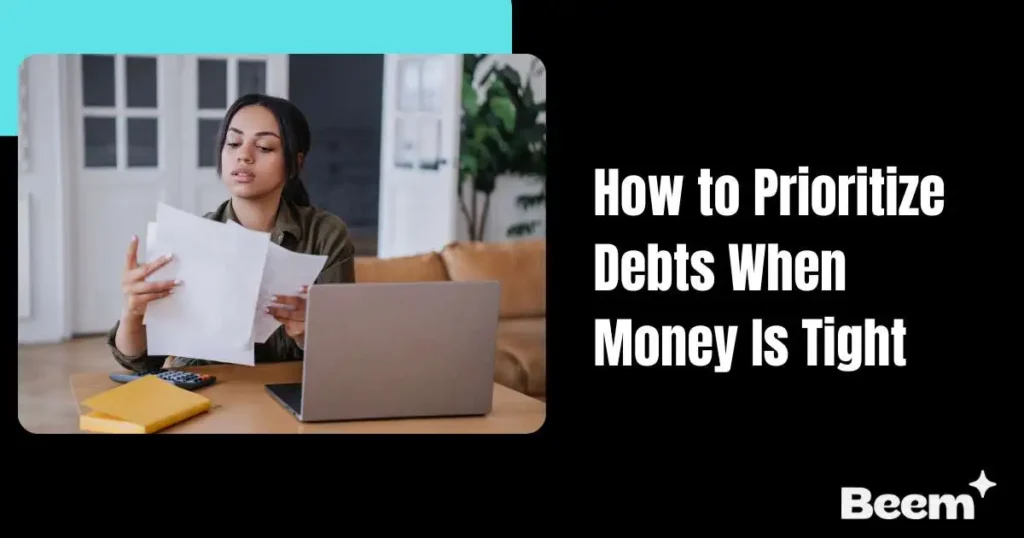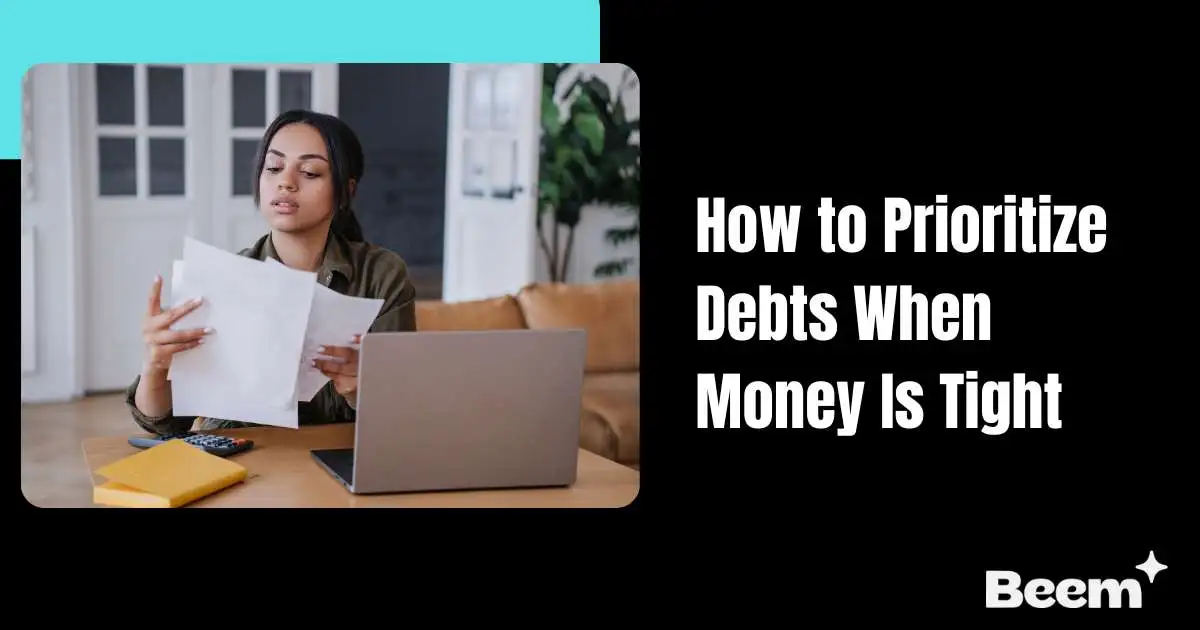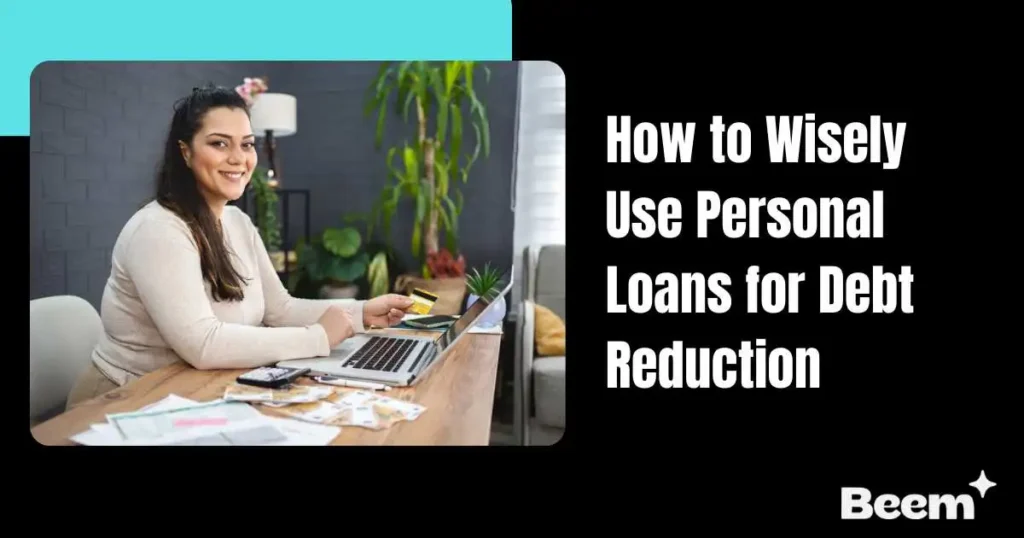At A Glance
Let’s be honest, managing debt when you’re already stretching every dollar can feel impossible. If you’re living paycheck to paycheck and still trying to keep up with credit card bills, loan payments, or overdue utility bills, you’re far from alone. Millions of people are in the same boat, struggling to stay financially afloat while dealing with rising costs and stagnant wages. How to prioritize debts when money is Tight is a crucial step toward regaining control and reducing stress during tough times.
The Challenge of Managing Debt When Money Is Tight
Debt isn’t just a financial problem; it’s deeply emotional. Opening your mailbox and seeing yet another bill you can’t afford to pay creates a unique kind of stress. It leads to a constant feeling of anxiety, guilt, and even shame, and over time, it can become overwhelming.
The good news is, you don’t need a perfect financial situation to start getting control of your Debt—you need a plan that works for your reality.
At Beem, we understand how stressful and overwhelming it can feel. Some tools can help you take manageable steps toward financial relief, such as our debt consolidation marketplace, where you can compare loans, reduce interest rates, and simplify your payments. Keep reading to help you find the most straightforward path forward.
Read Also: When to Consider Credit Counseling for Debt Relief
Understanding Your Debt: Identifying What You Owe
To manage your finances, list your debts, whether credit cards, personal loans, medical bills, or payday loans. Include balances, interest rates, and due dates. This overview will help you understand where you stand and build a focused, realistic plan to reduce your Debt.
List All Your Debts
Before planning, you must know precisely what you’re up against. That means writing down everything you owe, not just the big stuff. You might be surprised by what you uncover. Many forget about smaller balances or old accounts with lingering Debt.
Take some time to list:
- Credit cards
- Student loans/ Personal loans
- Car loans
- Medical bills
- Rent or mortgage
- Overdue utility bills
- Payday loans
Your debts are scattered. Some are in apps, mailed, others emailed, or in online portals you rarely log into. Plan well. You can get help by using financial tools like Beem, which can pull everything into one dashboard so you can see the whole picture without digging through a mountain of statements.
Types of Debt
All Debt is not created equal, so knowing the difference between priority and non-priority Debt can help determine what to pay first.
Priority debts are tied to housing, transportation, and basic utilities. Missing these can result in serious consequences, such as eviction, repossession, or having your lights shut off.
Credit cards, personal loans, and medical bills are non-priority debts. These are still important, but missing a payment won’t immediately threaten your living situation.
Interest Rates and Payment Terms
Every Debt has its rules: different interest rates, payment due dates, and late penalties. For example, credit cards often carry interest rates of 20% or more, while federal student loans may sit below 7%.
For example, if you owe $5,000 on a credit card with a 22% APR and only make minimum payments, you could pay over $1,100 in interest in just one year. That’s money that could have gone toward your savings or other needs.
Beem helps you identify opportunities to consolidate high-interest debts into one loan with a lower rate.
How to Prioritize Your Debts When Money Is Tight
Start by paying for essentials like housing, food, and utilities. Then, focus on high-interest debts like credit cards or payday loans. Make minimum payments on others to avoid penalties. Use tools like Beem to explore consolidation options and stay on track with budgeting.
1. Pay the Essentials First
Start by securing the basics: a place to live, food on the table, utilities, and a way to get to work. These are non-negotiables. After covering essentials, you may not have much left for everything else, and that’s okay. It just means tightening up wherever possible. Cut back on non-essentials like takeout, subscriptions, or impulse buys. Build a “survival budget” focusing only on necessities and minimum debt payments.
2. Focus on High-Interest Debts
High-interest debts like credit cards and payday loans are the most expensive. Knocking them down first will save you more money in the long run.
Try this: Use the Debt Avalanche Method – a simple method that involves paying the minimum on all debts, but throwing any extra toward the one with the highest interest rate.
Watching balances shrink by tiny amounts each month can be discouraging. Look into debt consolidation through Beem. You could trade several high-interest debts for one lower-interest loan if you qualify. That means one payment, less interest, and less stress.
3. Minimize Missed Payments and Late Fees
Missing payments, even small ones, can cost you. There are immediate late fees and long-term damage to your credit and interest rate hikes. To avoid missed payments, set calendar reminders, automate minimum payments, or use apps that notify you before due dates. Beem users get real-time alerts for upcoming bills and credit score changes, so nothing falls through the cracks.
4. Consolidate Debts When Possible
Consolidation doesn’t mean “more debt”; it means reworking what you already owe into something more manageable. You’re not adding Debt, you’re putting your existing Debt into a better container.
The benefits of consolidation include lower interest rates, one monthly payment, less stress, and faster payoff. Beem’s consolidation marketplace lets you compare loan offers side-by-side, so you can choose what fits your budget.
Also Read: What to Do If You’re Facing Debt Collection Calls
Ways to Increase Your Income for Debt Repayment

Boosting your income can speed up debt repayment. Consider side hustles like freelancing, gig work, or selling unused items. Explore part-time jobs or remote opportunities. Use your skills to offer services locally.
Paying off Debt isn’t just about cutting back. Increasing your income, even a little, can go a long way toward accelerating your progress. Here are some ways:
1. Side Hustles and Gig Work
A side hustle can give your budget some breathing room if you have a few extra hours a week. There are many options, such as food delivery (DoorDash, UberEats), freelance writing, design, or tutoring (Upwork, Fiverr), dog walking or pet sitting (Rover), and selling crafts or vintage items (Etsy). This can be tiring, but 5–10 hours a week can make a difference.
2. Sell Unused Items
Decluttering your home could be a financial opportunity and a nice way to redecorate! Look for old phones or laptops, furniture, designer clothing, collectibles, or hobby gear. Though it might be tough to let go, remember you’re trading those items for peace of mind and financial freedom.
3. Rent Out Space
Got extra space at home? Put it to work! You can rent a spare bedroom on Airbnb, lease your driveway or garage, or even offer storage space. It doesn’t have to be a long-term commitment, just a way to bring in extra cash when needed. It’s for a month or a season, turning unused space into income can give you the financial cushion and peace of mind you want.
Real-Life Example: How Jane Reduced Her Debt Using These Strategies
Meet Jane. She’s a 32-year-old freelance graphic designer. When COVID hit, her income plummeted, and her credit card debt skyrocketed to $12,000. With inconsistent income and missed payments, she was overwhelmed and anxious.
Her challenges were a high credit card interest (22–27%), and she had missed minimum payments, which led to financial anxiety.
What did Jane do? She followed these five steps to overcome her challenges:
1. She paid essentials first – made sure rent and groceries were covered before anything else.
2. She got organized. She used financial apps like Beem to list her debts, due dates, and interest rates in one place.
3. She used the Avalanche Method. She made minimum payments on three cards and deposited all extra funds into the highest-interest one.
4. Consolidated – After a few months, she qualified for a debt consolidation loan through Beem at 10.5%, which cut her monthly payments by 30%.
5. Boosted income – Jane picked up weekend freelance gigs and sold old tech gear she wasn’t using. This helped her earn extra money and ease her financial stress.
The results: she could pay off $7,000 in six months, improving her credit score as it jumped 60 points, built a $500 emergency fund, and stopped relying on credit cards.
Jane’s journey shows that progress is possible even when things feel bleak—one decision, payment, and gig at a time.
Using Beem to Track Your Debt Repayment Progress
Beem has a Budget Planner tool to help you manage your money wisely. This function allows you to analyze your income and expenses, establish spending restrictions, and locate savings opportunities to keep your finances on track while boosting your credit score. Your BFF – Better Financial Feed™ will alert you to potential overdrafts, costs, and revenue made, helping you better understand your money.
Beem provides free credit monitoring services, making them accessible to everyone. Unlike competitors that charge hidden or membership fees, Beem prioritizes openness and affordability. While the free service includes sophisticated features such as real-time notifications and extensive credit analytics, customers may upgrade to premium plans.
These advanced alternatives provide extra value to anyone seeking complete credit monitoring and protection. Beem’s Everdraft™ allows for better financial management and avoiding overdraft penalties, perhaps improving credit. Making on-time payments and avoiding financial shortages may increase your total credit score.
Taking Control of Your Debt and Financial Future
Regaining control of your Debt may seem overwhelming, especially when money is tight, but it’s possible with the right strategy and tools. Start by focusing on essential expenses, creating a realistic budget, and prioritizing high-interest debts.
Resources like Beem’s debt marketplace can help you find lower-interest consolidation options and simplify payments. No matter how small, every step you take brings you closer to financial stability. The key is consistency and a willingness to make gradual progress. Don’t be discouraged by setbacks; stay focused on your goals and celebrate each win.
Debt doesn’t have to control your life. With patience, planning, and persistence, you can reduce your Debt and build a stronger financial future. Empower yourself to take charge today; you have the tools and the strength to succeed.
FAQs on How to Prioritize Debts When Money Is Tight
How can I prioritize paying off Debt when I have multiple bills?
Start by covering essential expenses like housing, food, and utilities to maintain stability. Focus on high-interest debts like credit cards and payday loans, which grow fastest. Create a monthly budget and stick to it, allocating extra funds toward the highest-interest Debt. Avoid late fees by making at least the minimum payments on all other bills.
Is debt consolidation the best option with multiple credit cards?
Debt consolidation can be smart if you’re juggling multiple credit cards. It simplifies your finances by combining debts into one manageable monthly payment, often at a lower interest rate. This can reduce stress and save money over time. Using Beem’s marketplace makes it easier to compare lenders and find the best deal for your situation.
What is the debt avalanche method, and how can it help me save money?
The debt avalanche method targets your highest-interest debts first while making minimum payments on the rest. Once the most expensive Debt is paid off, you roll that payment into the next highest-interest Debt. This strategy reduces the total interest paid and can help you become debt-free faster. It requires discipline but is highly effective for long-term savings.
How can I prevent my Debt from worsening when money is tight?
When money’s tight, create a strict budget and track every expense. Make minimum payments on all debts to avoid late fees and credit damage, and look for ways to cut non-essential spending. Tools like Beem can help you explore lower-interest debt consolidation loans that reduce monthly payments. Consider negotiating with creditors or exploring forbearance options.
Can I get help with my Debt if I have little income?
Yes, even with limited income, there are ways to manage Debt. Start by trimming unnecessary expenses and prioritizing essentials. Debt consolidation can lower monthly payments, primarily through services like Beem. Look into side hustles or part-time work to generate extra income. Some creditors may offer hardship programs or reduced payment plans. Stay disciplined with budgeting and avoid taking on new high-interest Debt.












